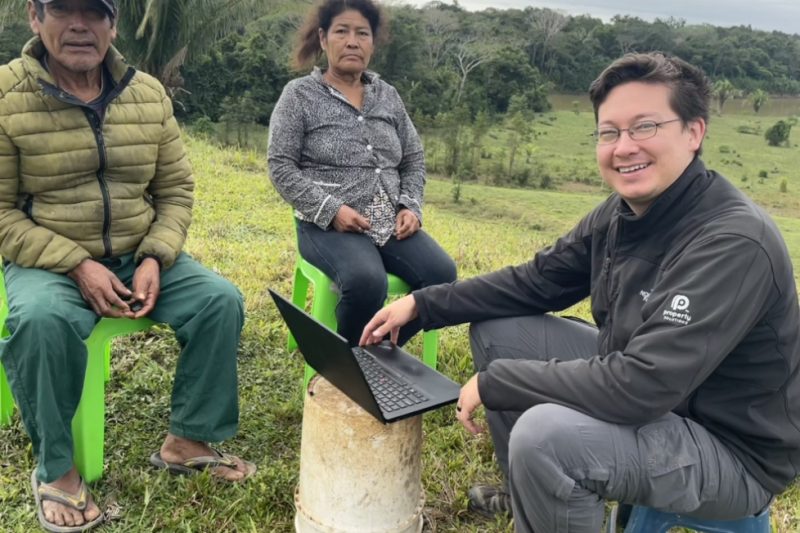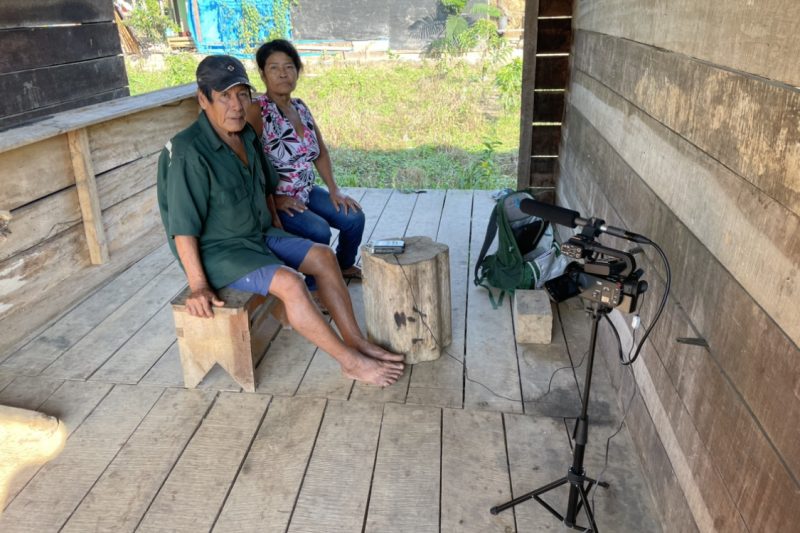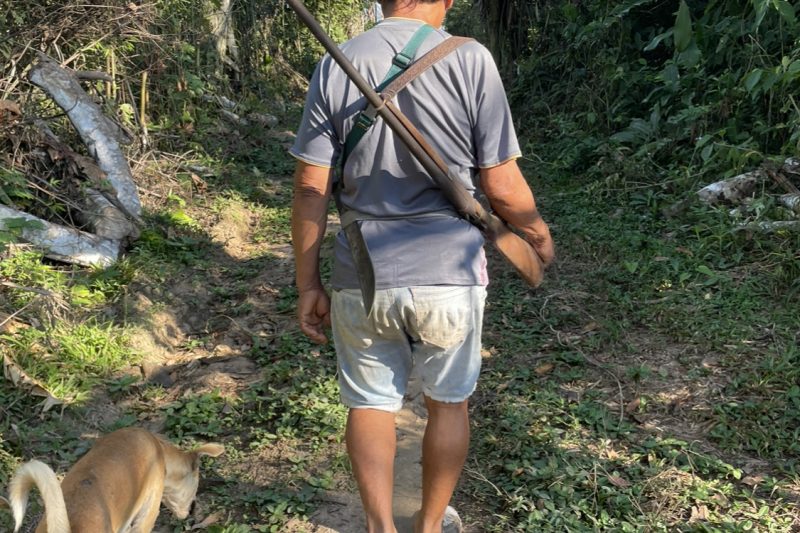From Texas to the Peruvian Amazon, a UT Researcher Preserves a Dying Language
By Michael Nolan
Reporting Texas

University of Texas linguistics doctoral student Barrett Hamp, right, works to record Maria Silviano and Jorge Silviano, two of the last people known to still speak the Iñapari language. Photo courtesy of Barrett Hamp
Nestled deep in the Amazon basin, a makeshift house sits alongside a rustic nut storage facility. Two of the occupants of this house in Peru’s remote Madre de Dios District, Jorge Silvano and his sister Maria Silvano, might be the last chance of survival for the endangered language Iñapari.
Meanwhile, over 3,000 miles away, a doctoral student is huddled over his laptop in the Robert L. Patton building at the University of Texas at Austin. He has roughly 60 hours of raw recordings to analyze from his trips to Peru. He’s in a race against time to understand a language with only four known speakers, all over 60 years old.
Barrett Hamp, a UT doctoral student in linguistics, has dedicated his research since 2019 to recording the language to prevent it from disappearing.
“Once a language is gone, it’s gone. There’s no reviving it,” Hamp said.
Hear one of Hamp’s recordings of Jorge and Maria Silvano speaking their Iñapari language:
The United Nations Permanent Forum for Indigenous Issues estimates that one indigenous language dies every two weeks and that half of the world’s languages will be extinct by 2100.
Hamp developed an interest for linguistics after living with a Kichwa family in Ecuador and learning the language during his undergraduate degree. Upon returning from Ecuador, he began working with a professor who specialized in the Kichwa language.
Hamp credits his previous traveling experience in South America for truly developing his passion.
“I lived in a Christian temple in Ecuador. I stayed with Mennonites in Bolivia. I spent a night with Argentinian street performers in Colombia,” he said. “It was realizing that not everybody is going to go out and do that kind of stuff, that prompted me to look for the out-there languages”
Hamp previously researched the Tolupan indigenous group in Honduras but had to stop because of turbulent circumstances in the country. So, he began looking for a new research topic and stumbled upon some 20th century writings on the Iñapari.
Prior to Hamp’s current work, the last published work on the Iñapari was a short 39-page sketch of the language by another linguist, Steve Parker, in 1999.
“My first pitch was let’s go see if they’re still there,” said Hamp, who first ventured to the village of Sabulayo in the Peruvian jungle in 2019 to try to find any remaining speakers.
Hamp found the subject of Parker’s previous work, Jorge Silvano, still living there with his sister, Maria. The only other speakers of the language are their two brothers, who have yet to have direct contact with Hamp.
Little is known about the history of the Iñapari people, but anecdotal evidence from Jorge and Maria provides an understanding of how the language has come so close to dying. According to their father and uncle, there were around 30 Iñapari tribal members in the middle of the 20th century. During the Second World War, South America experienced a minor rubber boom as Japan captured Malaysia, reducing global rubber access. Jorge and Maria recounted that the Iñapari were forcefully taken across the border to Bolivia to work on rubber plantations, a well-documented occurrence for indigenous groups during the 19th and 20th centuries in South America.

Jorge Silviano, left, and his sister, Maria, record themselves speaking the Iñapari language for University of Texas researcher Barrett Hamp. Barrett Hamp/University of Texas
Jorge and Maria’s father managed to escape the plantation. He went on to parent the final four Iñapari speakers in the world with a member of the Mashco-Piro, an indigenous tribe that still survives and has minimal contact with the outside world. No other descendants are known from the Iñapari who were forcefully displaced during the rubber boom.
The Iñapari language is a member of the Arawakan language family, which was the largest language family in the Americas prior to Christopher Colombus’ arrival. Taíno, an Arawakan language, is actually the source of multiple common English words such as Iguana, Hammock, and Barbecue, according to Hamp. The closest related language to Iñapari is Yine, another Arawakan language, which had around 2000 speakers in 2011.
Hamp’s work with Jorge and Maria focuses on transcribing the Iñapari language. This ranges from documenting words and phrases to more complex practices such as on Hamp’s last trip when he focused on valency changing operations, which is the number of arguments a verb can take in a sentence.
The Iñapari did not previously have a writing system, until Jorge developed a writing system with FENEMAD, an organization which advocates for indigenous rights in the Madre de Dios territory in Southeastern Peru. Hamp transcribes Iñapari utilizing the International Phonetic Alphabet system, which is the global standard alphabet for representing human sounds in linguistics.
The implications of transcribing endangered languages are important. “Their documentation supports speakers and their descendants in safeguarding their cultural heritage,” said Patience Epps, a UT linguistics professor who has worked researching numerous indigenous South American languages.
“In the case of Iñapari, this work is particularly urgent,” Epps said. “This is really the last opportunity to create a robust and lasting record of this language.”
Hamp will be venturing back to Peru in January in order to attempt to make contact with the final two speakers in hopes it will help spur even more understanding of the Iñapari language.
“Language documentation never really ends,” Hamp said.

Jorge Silviano, one of the last four known Iñapari speakers in the world, hunts to provide dinner for his family in Peru. Barrett Hamp/University of Texas